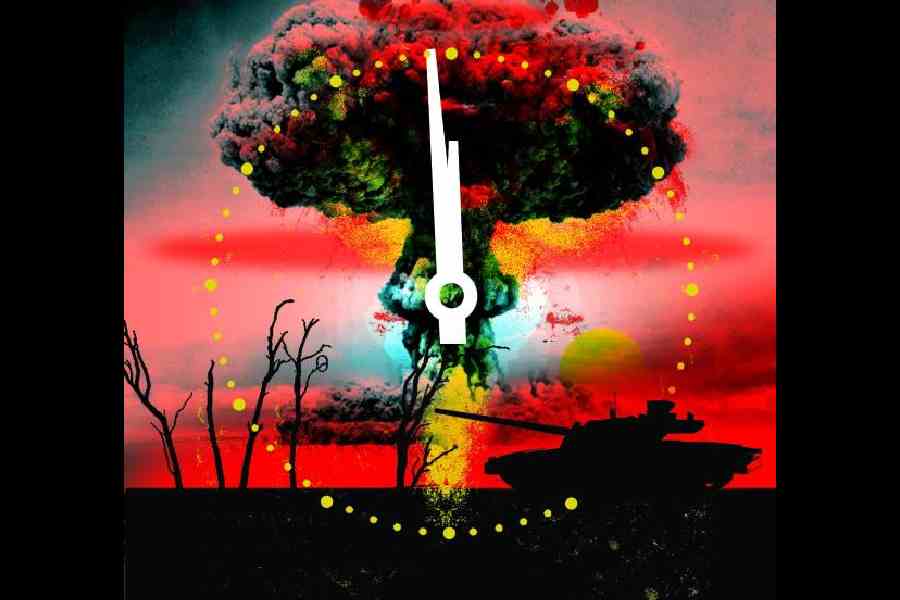The Bomb and I go way back. In Seattle, US, where I grew up in the 1950s and ’60s, it was common wisdom that in the event of nuclear war, we were No. 2 on the target list because Seattle was the home of Boeing, maker of B-52 bombers and Minuteman missiles.
In school, we had various drills for various catastrophes, and we had to remember which was which. Earthquake? Run outside. The Bomb? Run inside, to an inner corridor that had no windows.
I was sent on this trip down memory lane by the announcement on January 23 from the Bulletin of the Atomic Scientists that it had decided not to change the setting of the Doomsday Clock, a metaphorical timepiece invented in 1947 as a way to dramatise the threat of nuclear Armageddon. The clock was originally designed with a 15-minute range, counting down to midnight — the stroke of doom — and the Bulletin’s members move it from time to time in response to current events, which now include threats such as climate change and pandemics.
In a burst of optimism in 1991, after the Soviet Union broke up and the first Strategic Arms Reduction Treaty was signed, the clock was turned way back to 17 minutes to midnight. “The Cold War is over,” the Bulletin’s editors wrote. “The 40-year-long East-West nuclear arms race has ended.”
A year ago, after Russia invaded Ukraine and brandished the threat of using nuclear weapons, the clock was set to 90 seconds to midnight, the closest it has yet come to The End. The threat of nuclear weapons in Ukraine has diminished since then, but the clock remains poised at 90 seconds before zero.
This year’s announcement came on the same day Oppenheimer, Christopher Nolan’s biopic of the man who directed the invention of the Bomb, received 13 Oscar nominations. In an interview before the film’s release, Nolan described J. Robert Oppenheimer as the most important human in history because his invention had either made war impossible or doomed us to annihilation.
The jury is still out. Among cosmologists, the question is whether we are the only beings in the universe that have subjected ourselves to such a fate. How special are we and our doomsday clock?
Back in 1950, during a lunchtime conversation with colleagues about UFO sightings, physicist Enrico Fermi wondered aloud: “Where is everybody?” The cosmos is vast and possibly filled with alien life — so why are humans so seemingly alone?
In the 1970s and ’80s, astrophysicists Michael H. Hart and Frank J. Tipler expanded on what came to be known as the Fermi paradox. The Milky Way galaxy is 10 billion years old, they noted, but any intelligent civilisation that arose in it should need only 100 million years or so to visit or colonise every planet in it — perhaps by sending self-replicating robot probes into space so that the number of planets or stars visited would double, say, every 10,000 years.
Yet there is no evidence that Earth has been visited, or even pinged by interstellar radio signal — the Great Silence, radio astronomers call it. Why?
One simple answer is that other civilisations are too sparse in space and time for us to ever know of one another’s existence. Or that we truly are alone, despite the intimations of possibility in images from the James Webb Space Telescope of galaxies scattered like sand in the winds of time. Life arose on Earth within half a billion years of its formation, which suggests to hopeful astrobiologists that generating life is easy, at least in microbial form. Maybe intelligence is the hard part.
Another theory is that intelligent civilisations, when they do arise, don’t long survive their own intelligence, or at least not long enough to make a dent in the cosmos. Robin Hanson, an economist at George Mason University, US, has suggested that major civilisations inevitably succumb to what he calls the Great Filter: a barrier or series of them that either prevents life from forming in the first place or clips a technological race’s wings before it can go interstellar. War, pestilence, climate change and misbegotten genetic experiments are on the list of potential apocalypses. Are we lucky to have gotten this far, or is disaster ahead?
In the 1980s, Jeremiah P. Ostriker and Edwin L. Turner, astronomers at Princeton University, US, used mathematical models from ecology to explore the idea of galactic colonisation to which Hart and Tipler alluded. They proposed that a variety of intelligent civilisations would pop up everywhere in the galaxy and eventually interact, sometimes trading, sometimes fighting.
Any new intelligent civilisation appearing in that galaxy — humankind, for instance — would last only until its signals had been emitted long enough to be detected by the killer cosmic neighbours. Ostriker put “long enough” at maybe 5,000 years.
Any way you look at it, our prospects are grim. But there might be a threadbare glimmer of hope, for some forms of life at least. With another billion years to go before the sun burns Earth to a crisp, our planet’s most interesting life forms may be yet to come.
Of course, if we mind the Doomsday Clock, we could still change our ways and survive to inherit the galaxy. Even 90 seconds to midnight isn’t too late to improve our game in relation to one another and to Earth.
NYTNS










